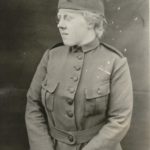
Salvation Lassie of Mine
One of the functions of The Salvation Army War Service in France and Germany was to operate hutments or huts. Designed to be mobile, huts were located in tents, dugouts and temporary or vacant buildings. Often female workers operated these huts. Their responsibilities included serving refreshments, providing music and writing materials, hosting religious services and offering prayer and spiritual counseling.
Hut menus included doughnuts, pies, cakes and oranges. Adjutants Helen Purviance and Margaret Sheldon were the first to make doughnuts. Using flour, sugar, lard, baking powder, cinnamon, and canned milk from camp supplies, they purchased eggs from a villager and began their doughnut production.
On the first day, they made 150 doughnuts. By the end of the war, some huts made 9,000 doughnuts per day. The Salvation Army quickly became known for this treat. Soldiers looked forward to doughnuts and hot coffee served with smiles and encouraging words from the Salvationist women, who they affectionately called “Doughnut Lassies” and “Doughnut Girls.”






